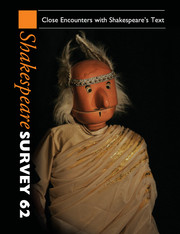Book contents
- Frontmatter
- Shakespeare, text and paratext
- The popularity of Shakespeare in print
- The continuing importance of new Bibliographical method
- ‘Honour the real thing’: Shakespeare, Trauma and Titus Andronicus in South Africa
- ‘O, these encounterers’: on Shakespeare’s meetings and partings
- A play of modals: Grammar and potential action in early Shakespeare
- Merry, marry, Mary: Shakespearian wordplay and Twelfth Night
- A subtle point: Sleeves, tents and ‘Ariachne’s broken woof’ (again)
- The look of Othello
- Red button Shakespeare
- ‘Mark you / his absolute shall?’: Multitudinous tongues and contested words in Coriolanus
- Chagall’s Tempest: An autobiographical reading
- Reading illustrated editions: Methodology and the limits of interpretation
- Close encounters with Anne Brontë's Shakespeare
- Shakespeare and the magic lantern
- Shakespeare and the coconuts: close encounters in post-apartheid South Africa
- The Schrödinger effect: Reading and misreading performance
- Behind the scenes
- Inner monologues: Realist acting and/as Shakespearian performance text
- More japanized, casual and transgender shakespeares
- Translation futures: Shakespearians and the foreign text
- After translation
- ‘The single and peculiar life’: Hamlet’s heart and the early modern subject
- Mapping King Lear
- ‘Last on the stage’: The place of Shakespeare in Charles Darwin’s ethology
- Sense/memory/sense-memory: Reading narratives of Shakespearian rehearsals
- Shakespeare performances in England (and Wales), 2008
- Professional Shakespeare productions in the British Isles, January–December 2007
- The Year's Contributions to Shakespearian Study 1 Critical Studies
- 2 Shakespeare in performance
- 3a Editions and textual studies
- 3b Editions and textual studies
- Index to Volume 62
‘Mark you / his absolute shall?’: Multitudinous tongues and contested words in Coriolanus
Published online by Cambridge University Press: 28 November 2009
- Frontmatter
- Shakespeare, text and paratext
- The popularity of Shakespeare in print
- The continuing importance of new Bibliographical method
- ‘Honour the real thing’: Shakespeare, Trauma and Titus Andronicus in South Africa
- ‘O, these encounterers’: on Shakespeare’s meetings and partings
- A play of modals: Grammar and potential action in early Shakespeare
- Merry, marry, Mary: Shakespearian wordplay and Twelfth Night
- A subtle point: Sleeves, tents and ‘Ariachne’s broken woof’ (again)
- The look of Othello
- Red button Shakespeare
- ‘Mark you / his absolute shall?’: Multitudinous tongues and contested words in Coriolanus
- Chagall’s Tempest: An autobiographical reading
- Reading illustrated editions: Methodology and the limits of interpretation
- Close encounters with Anne Brontë's Shakespeare
- Shakespeare and the magic lantern
- Shakespeare and the coconuts: close encounters in post-apartheid South Africa
- The Schrödinger effect: Reading and misreading performance
- Behind the scenes
- Inner monologues: Realist acting and/as Shakespearian performance text
- More japanized, casual and transgender shakespeares
- Translation futures: Shakespearians and the foreign text
- After translation
- ‘The single and peculiar life’: Hamlet’s heart and the early modern subject
- Mapping King Lear
- ‘Last on the stage’: The place of Shakespeare in Charles Darwin’s ethology
- Sense/memory/sense-memory: Reading narratives of Shakespearian rehearsals
- Shakespeare performances in England (and Wales), 2008
- Professional Shakespeare productions in the British Isles, January–December 2007
- The Year's Contributions to Shakespearian Study 1 Critical Studies
- 2 Shakespeare in performance
- 3a Editions and textual studies
- 3b Editions and textual studies
- Index to Volume 62
Summary
first citizen Before we proceed any further, hear me speak.
all Speak, speak.
first citizen You are all resolved rather to die than to famish?
all Resolved, resolved.
first citizen First, you know Caius Martius is chief enemy to the people.
all We know’t, we know’t.
first citizen Let us kill him, and we’ll have corn at our own price. Is’t a verdict?
all No more talking on’t. Let it be done. Away, away!
(1.1.1–12)The first moments of Coriolanus capture the clamour and defiance of 'a company of mutinous Citizens' and provide a fitting initiation into a dramatic environment that is saturated with competing forms of language. With this demonstration, a collision of voices that will be maintained and exploited over the course of the play is powerfully introduced. On one hand, the dominant noise belongs to the starving and querulous mob, whose chanted words seem unhinged from their typical interactive and communicative functions. The doubled words, all clipped vowels and hard consonants, acquire an incantatory quality more in line with extra-linguistic sounds than with units of dialogue. Yet even in the midst of this collective howl, a counter-force emerges. Out of the din rises the enlivening voice of the First Citizen, clarifying and directing the sound of the multitude. The result is a confluence of verbal styles; the mob's chanting is offset by a discrete, articulate voice, so that two systems of language - the excited babble of a group, and the exhortative voice of an orator - collide. The pattern of competing voices that is established here is repeated throughout the play and, indeed, the various implications of ‘voice’ provide a potent subtext. The mob’s racket provides a visceral signal of the warring voices that will populate the play, and the words of the individual citizens that emerge from the rabble reinforce the point. There is an early, marked emphasis on the conflict between command and resistance, especially in regard to permitted speech.
- Type
- Chapter
- Information
- Shakespeare Survey , pp. 141 - 150Publisher: Cambridge University PressPrint publication year: 2009
- 1
- Cited by

